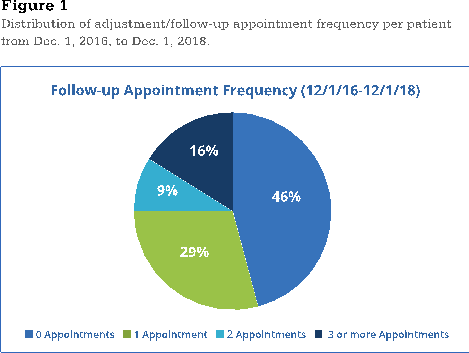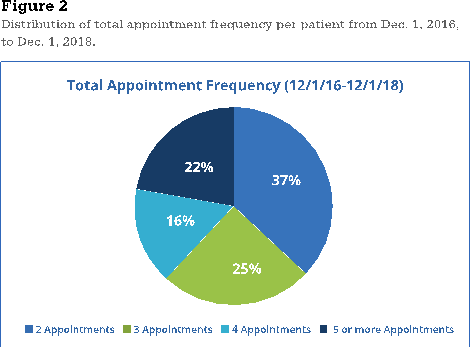Charcot Restraint Orthotic Walker (CROW) orthoses represent a unique and complex category of orthotic management. CROW orthoses affect the patient’s functional gait pattern, by restricting motion in the encompassed Charcot joint(s), as well as offload any existing ulceration and provide protection to underlying soft tissue.
Due to the complex and multifaceted care required, it is reasonable to anticipate appointments will be required beyond device delivery. Understanding the distribution and frequency of these appointments has the potential to help clinicians better understand the follow-up needs of the patient and identify clinical factors that may influence appointment follow-up frequency. This retrospective analysis attempted to characterize the frequency and distribution of appointments required by CROW patients at Scheck & Siress over a two-year period.
In the Scheck & Siress electronic medical record (EMR) and scheduling system, there are four primary appointment types related to CROW patient care: casting, delivery, adjustments, and follow-ups. For the purposes of this analysis, the frequency of follow-ups and adjustments were combined to create a single follow-up value. This is because when scheduling appointments, there is no clear delineation between the care provided at an adjustment versus a follow-up.
This review utilized the per-patient frequency of these appointment types from all Scheck & Siress locations from Dec. 1, 2016, to Dec. 1, 2018. The initial data included appointment types and frequencies for 329 patients. To be eligible for inclusion, patients must have had at least one casting and at least one delivery appointment for a CROW orthosis within the two-year period; 170 patients in the Scheck & Siress system met this inclusion requirement.
Data Collection and Analysis
Collectively, the 170 patients had 207 casting appointments (32.14 percent), 218 delivery appointments (33.85 percent), and 219 follow-up appointments (34.01 percent), for a total of 644 patient encounters. There was an average of 1.22 ± 0.47 casting appointments per patient, 1.28 ± 0.61 delivery appointments per patient, 1.29 ± 2.25 follow-up appointments per patient, and 3.79 ± 2.57 total appointments per patient. In all, 46.47 percent of the 170 patients required no adjustments, and 53.53 percent one or more follow-up appointments (Figure 1). In addition, 36.47 percent of the 170 patients required two total appointments over the two-year period; 77.65 percent required four total appointments or less, and 22.35 percent required five or more appointments (Figure 2).
The findings of this retrospective analysis indicate that the majority of patients require at least one follow-up appointment corresponding with a casting and delivery appointment, potentially indicating that the scope of care often extended beyond device delivery. Variations in the frequency of total and follow-up appointments perhaps highlight an existing dichotomy among different clinical presentations of CROW patients and the necessary care protocol. Factors contributing to this dichotomy may include stage of Charcot progression, general patient compliance, existence of comorbidities, severity and existence of ulceration, or practitioner-specific follow-up protocol.
This preliminary analysis did not distinguish between patients requiring one casting and delivery appointment with those requiring greater than one casting or one delivery appointment in the two-year time frame. Additionally, there was not a required order of appointments for inclusion; therefore, it is possible that follow-ups included applied to a previously delivered CROW orthosis prior to casting for the new CROW. It also is possible that the appointment-type descriptor was not appropriate in all patient encounters, leading to the mislabeling of the services provided during the appointment.


Conclusion:
Moving forward, this initial analysis may be helpful in setting the stage for a larger discussion regarding the standard frequency and distribution of follow-up appointments. Based on the findings presented here, it is beneficial for practitioners to investigate not only follow-up appointment frequency but the timing relative to the initial device delivery.
Further research should be done to establish the relationship between patient-specific characteristics and follow-up frequency. Improving this understanding enables clinicians to better predict the needs of their patient, provides valuable insight into the patient factors that indicate a need for increased follow-up care, and may help inform the development of a standard follow-up care protocol.
Claire Kilpatrick is a prosthetic/orthotic resident at Scheck & Siress.

